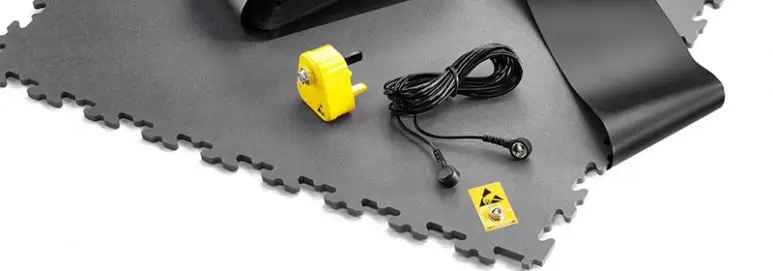The packaging industry used the terms “static dissipative” and “conductive” to categorise materials based on their ability to shield components from electrostatic damage.
-
- Static Dissipative Range – 106 – 108 Ohms
-
- Conductive Range – Between 104 & 106 Ohms
The Electronics Component Industry Association originally declared that conductive materials offer better shielding than static-dissipative materials.
Official ESD standards and test methods were developed as studies realised the impact of humidity, different environments and body voltage (static generated from walking).
What are the ESD floor test methods?
Surface Resistance UK & Europe: BS EN 61340/5 or USA / North America: ANSI/ESD 7.1
Surface resistance testing is the primary method for evaluating ESD flooring, as it’s a simple and repeatable test. The surface resistance of a material is the electrical resistance between two points on the surface. It’s tested by placing two electrodes on the surface of the flooring material and applying a voltage. The resistance between the electrodes measures how easily static electricity can flow across the material’s surface. The lower the surface resistance, the better the conductivity of the material.
The Walking (Body Voltage) Test
While surface resistance testing helps evaluate the conductivity of the flooring material, it doesn’t account for the effect of a person walking on the surface. The walking test, also known as the body voltage test, evaluates the flooring system’s ability to reduce static build-up as people walk on it.
The test subject is equipped with a special device that measures the voltage generated when walking. The test results indicate how effectively the flooring system dissipates static charge caused by human movement.
What are the ESD standards in different industries?
Electronics Industry
The most widely recognised standard for developing an ESD control program in the electronics industry is BS EN 61340 for the UK and across Europe or ANSI/ESD S20.20 in North America.
This standard outlines details about flooring and how it interacts with personnel. The standard requires that the surface resistance ranges be below 109 and the body voltage generation is below 100 volts.
Communications
MOTOROLA R56 is the most complete and rigorous specification for protecting communication system equipment installed at public safety and commercial wireless communication sites. Flooring requirements are 106 – 109 when measured using ANSI/ESD 7.1.
The Alliance for Telecommunications Industry Solutions for electrical protection of network operator equipment developed ATIS-0600321. Flooring requirements are 106 – 1010 when measured using ANSI/ESD 7.1.
Data Centres
IBM Data Center Recommendations
Although not an official standard, IBM recommends that floors in data centres have a surface resistance below 2 x 1010
Military and Specialised ESD Floors
The military has specific floor coverings requirements depending on the area and its operations. For example, we’ve recently worked with the UK’s Ministry of Defence to develop a conductive floor for an Ammunition Process Building.
Need help determining if you need an ESD floor or have a technical question? Give us a call on 01582 788 232 or email [email protected]
Click here for more ESD flooring resources



